Level 6 Public Health: Management of Child Abuse - Science & Practice
VerifiedAdded on 2023/06/15
|7
|1999
|446
Essay
AI Summary
This essay explores the multifaceted issue of child maltreatment, encompassing physical, sexual, and psychological abuse, along with neglect, and its impact on public health. It argues that child abuse is a significant public health concern with far-reaching consequences, including social, behavioral, emotional, and economic adversities for affected children. The essay highlights the importance of prevention strategies and addressing underlying risk factors to reduce the prevalence of child abuse. It also touches upon the ethical considerations involved in research and intervention related to child abuse, emphasizing the need for informed consent, autonomy, and ensuring the safety and well-being of children. The essay concludes by advocating for policy studies to evaluate the effectiveness of different approaches to child abuse prevention and intervention, emphasizing the need for a comprehensive and multi-faceted approach to protect children from maltreatment. Desklib provides solved assignments and resources for students.
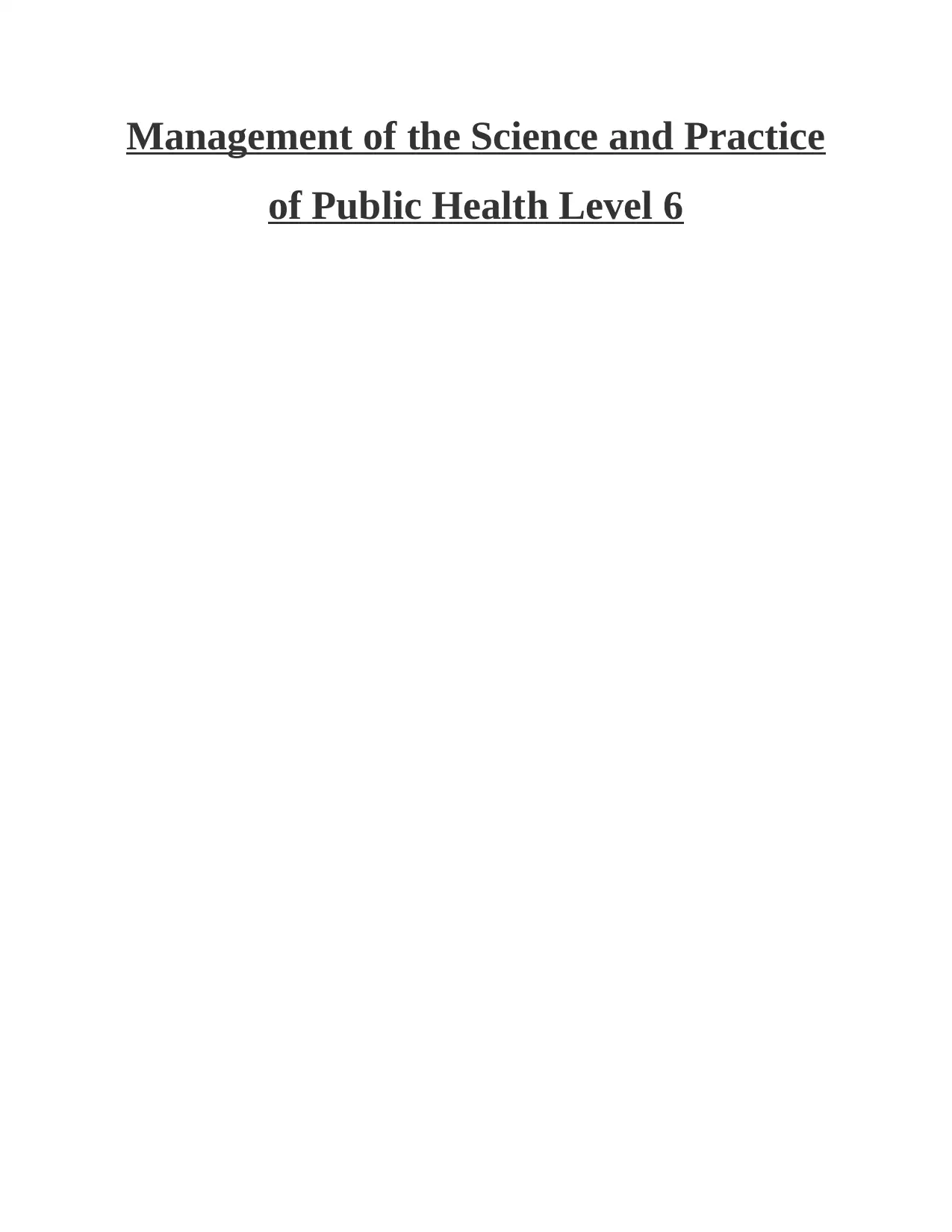
Management of the Science and Practice
of Public Health Level 6
of Public Health Level 6
Paraphrase This Document
Need a fresh take? Get an instant paraphrase of this document with our AI Paraphraser
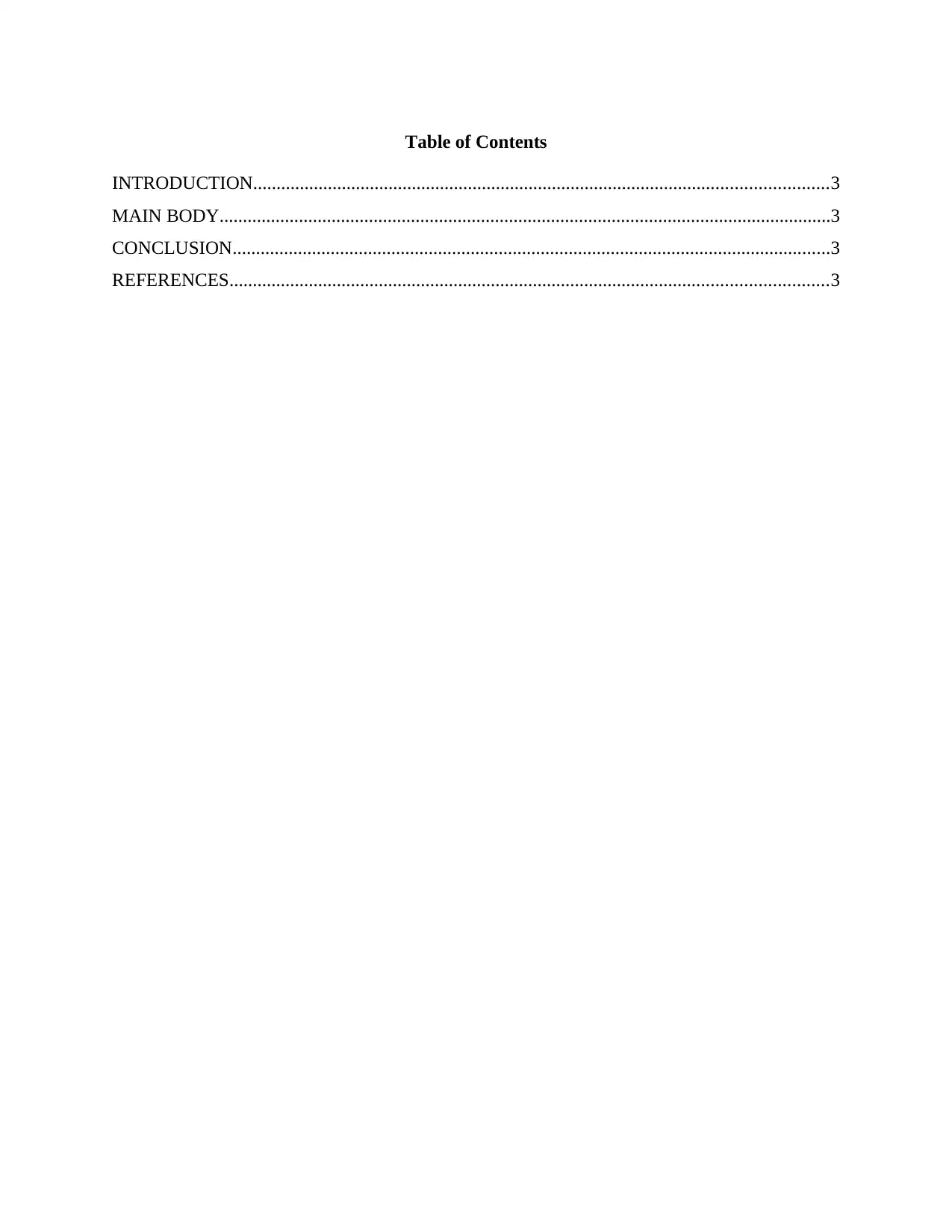
Table of Contents
INTRODUCTION...........................................................................................................................3
MAIN BODY...................................................................................................................................3
CONCLUSION................................................................................................................................3
REFERENCES................................................................................................................................3
INTRODUCTION...........................................................................................................................3
MAIN BODY...................................................................................................................................3
CONCLUSION................................................................................................................................3
REFERENCES................................................................................................................................3
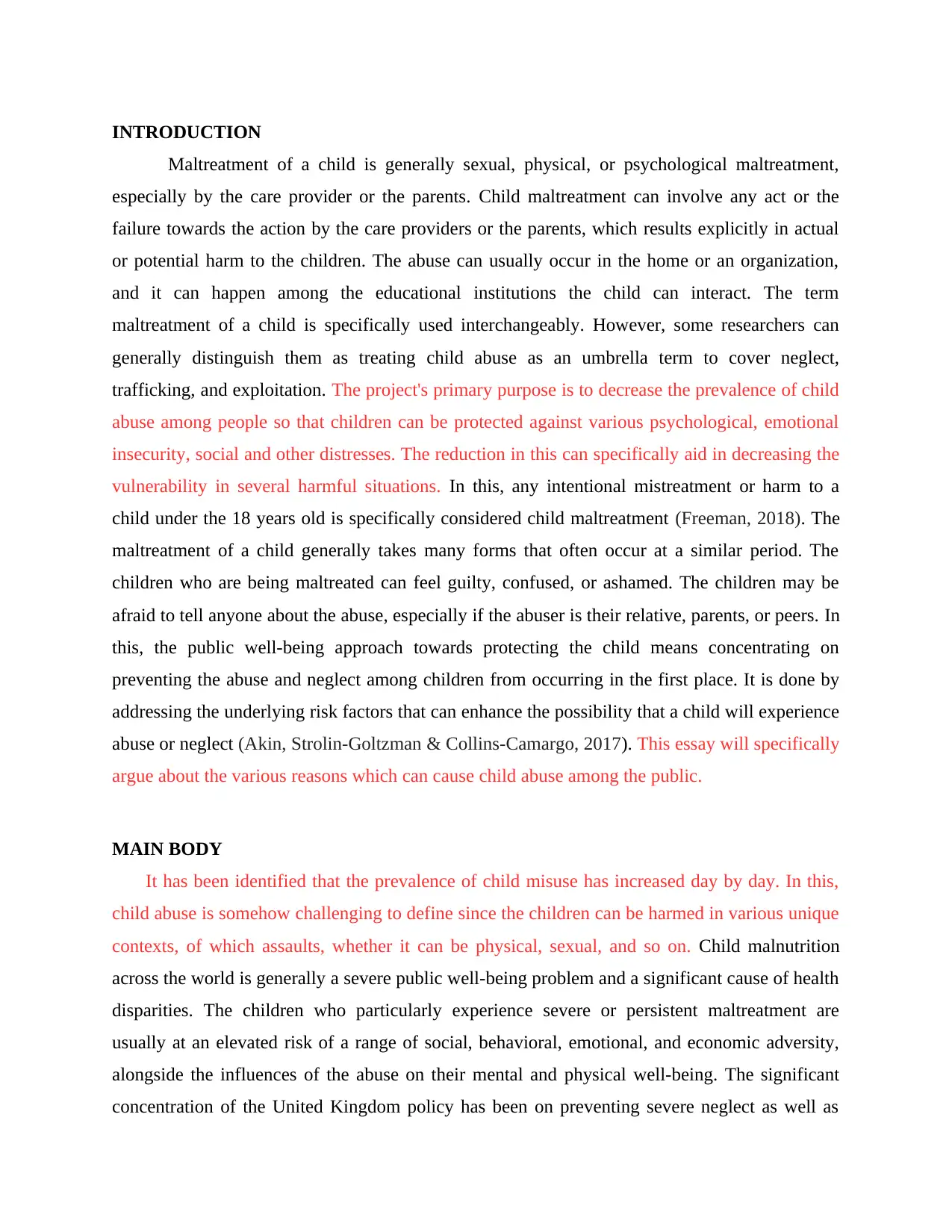
INTRODUCTION
Maltreatment of a child is generally sexual, physical, or psychological maltreatment,
especially by the care provider or the parents. Child maltreatment can involve any act or the
failure towards the action by the care providers or the parents, which results explicitly in actual
or potential harm to the children. The abuse can usually occur in the home or an organization,
and it can happen among the educational institutions the child can interact. The term
maltreatment of a child is specifically used interchangeably. However, some researchers can
generally distinguish them as treating child abuse as an umbrella term to cover neglect,
trafficking, and exploitation. The project's primary purpose is to decrease the prevalence of child
abuse among people so that children can be protected against various psychological, emotional
insecurity, social and other distresses. The reduction in this can specifically aid in decreasing the
vulnerability in several harmful situations. In this, any intentional mistreatment or harm to a
child under the 18 years old is specifically considered child maltreatment (Freeman, 2018). The
maltreatment of a child generally takes many forms that often occur at a similar period. The
children who are being maltreated can feel guilty, confused, or ashamed. The children may be
afraid to tell anyone about the abuse, especially if the abuser is their relative, parents, or peers. In
this, the public well-being approach towards protecting the child means concentrating on
preventing the abuse and neglect among children from occurring in the first place. It is done by
addressing the underlying risk factors that can enhance the possibility that a child will experience
abuse or neglect (Akin, Strolin-Goltzman & Collins-Camargo, 2017). This essay will specifically
argue about the various reasons which can cause child abuse among the public.
MAIN BODY
It has been identified that the prevalence of child misuse has increased day by day. In this,
child abuse is somehow challenging to define since the children can be harmed in various unique
contexts, of which assaults, whether it can be physical, sexual, and so on. Child malnutrition
across the world is generally a severe public well-being problem and a significant cause of health
disparities. The children who particularly experience severe or persistent maltreatment are
usually at an elevated risk of a range of social, behavioral, emotional, and economic adversity,
alongside the influences of the abuse on their mental and physical well-being. The significant
concentration of the United Kingdom policy has been on preventing severe neglect as well as
Maltreatment of a child is generally sexual, physical, or psychological maltreatment,
especially by the care provider or the parents. Child maltreatment can involve any act or the
failure towards the action by the care providers or the parents, which results explicitly in actual
or potential harm to the children. The abuse can usually occur in the home or an organization,
and it can happen among the educational institutions the child can interact. The term
maltreatment of a child is specifically used interchangeably. However, some researchers can
generally distinguish them as treating child abuse as an umbrella term to cover neglect,
trafficking, and exploitation. The project's primary purpose is to decrease the prevalence of child
abuse among people so that children can be protected against various psychological, emotional
insecurity, social and other distresses. The reduction in this can specifically aid in decreasing the
vulnerability in several harmful situations. In this, any intentional mistreatment or harm to a
child under the 18 years old is specifically considered child maltreatment (Freeman, 2018). The
maltreatment of a child generally takes many forms that often occur at a similar period. The
children who are being maltreated can feel guilty, confused, or ashamed. The children may be
afraid to tell anyone about the abuse, especially if the abuser is their relative, parents, or peers. In
this, the public well-being approach towards protecting the child means concentrating on
preventing the abuse and neglect among children from occurring in the first place. It is done by
addressing the underlying risk factors that can enhance the possibility that a child will experience
abuse or neglect (Akin, Strolin-Goltzman & Collins-Camargo, 2017). This essay will specifically
argue about the various reasons which can cause child abuse among the public.
MAIN BODY
It has been identified that the prevalence of child misuse has increased day by day. In this,
child abuse is somehow challenging to define since the children can be harmed in various unique
contexts, of which assaults, whether it can be physical, sexual, and so on. Child malnutrition
across the world is generally a severe public well-being problem and a significant cause of health
disparities. The children who particularly experience severe or persistent maltreatment are
usually at an elevated risk of a range of social, behavioral, emotional, and economic adversity,
alongside the influences of the abuse on their mental and physical well-being. The significant
concentration of the United Kingdom policy has been on preventing severe neglect as well as
⊘ This is a preview!⊘
Do you want full access?
Subscribe today to unlock all pages.

Trusted by 1+ million students worldwide
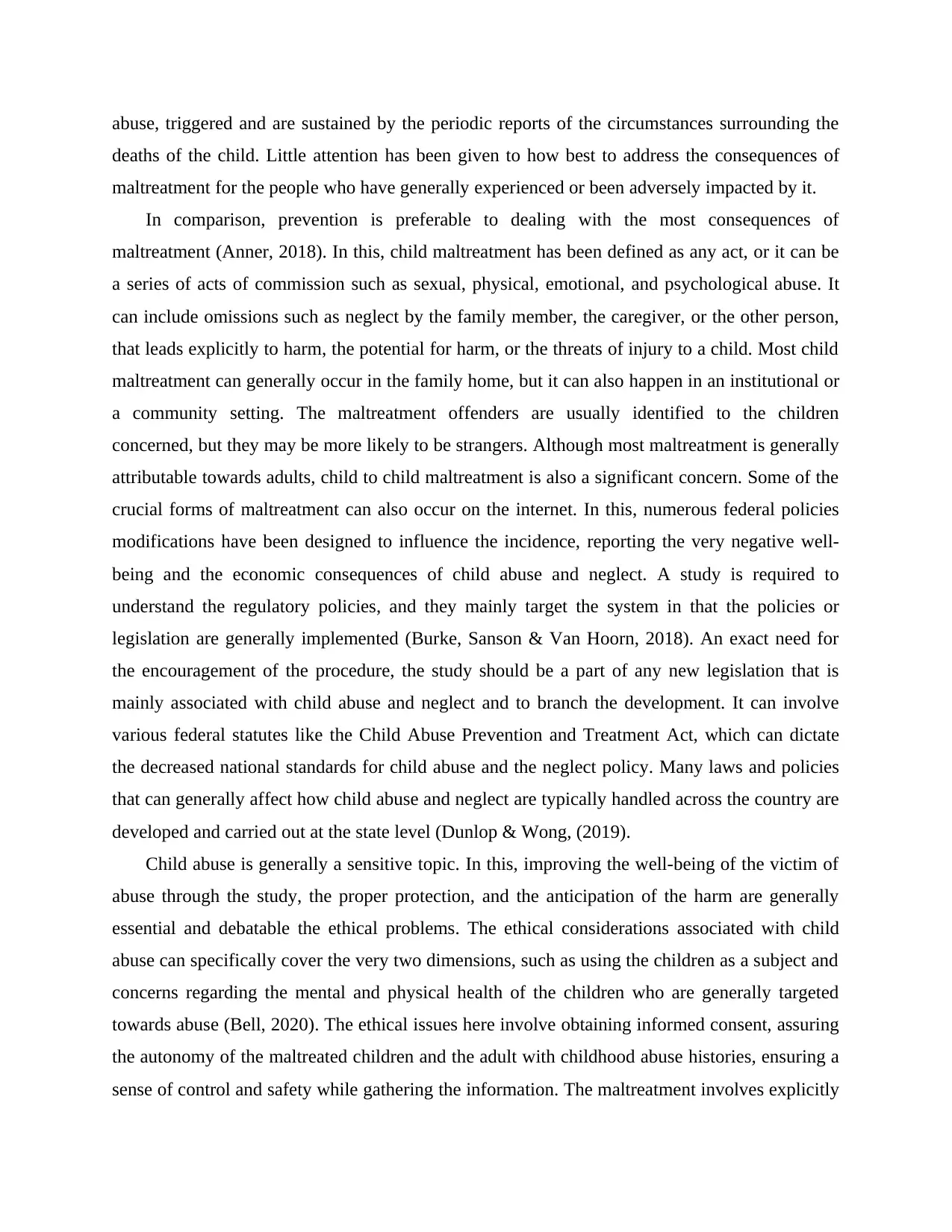
abuse, triggered and are sustained by the periodic reports of the circumstances surrounding the
deaths of the child. Little attention has been given to how best to address the consequences of
maltreatment for the people who have generally experienced or been adversely impacted by it.
In comparison, prevention is preferable to dealing with the most consequences of
maltreatment (Anner, 2018). In this, child maltreatment has been defined as any act, or it can be
a series of acts of commission such as sexual, physical, emotional, and psychological abuse. It
can include omissions such as neglect by the family member, the caregiver, or the other person,
that leads explicitly to harm, the potential for harm, or the threats of injury to a child. Most child
maltreatment can generally occur in the family home, but it can also happen in an institutional or
a community setting. The maltreatment offenders are usually identified to the children
concerned, but they may be more likely to be strangers. Although most maltreatment is generally
attributable towards adults, child to child maltreatment is also a significant concern. Some of the
crucial forms of maltreatment can also occur on the internet. In this, numerous federal policies
modifications have been designed to influence the incidence, reporting the very negative well-
being and the economic consequences of child abuse and neglect. A study is required to
understand the regulatory policies, and they mainly target the system in that the policies or
legislation are generally implemented (Burke, Sanson & Van Hoorn, 2018). An exact need for
the encouragement of the procedure, the study should be a part of any new legislation that is
mainly associated with child abuse and neglect and to branch the development. It can involve
various federal statutes like the Child Abuse Prevention and Treatment Act, which can dictate
the decreased national standards for child abuse and the neglect policy. Many laws and policies
that can generally affect how child abuse and neglect are typically handled across the country are
developed and carried out at the state level (Dunlop & Wong, (2019).
Child abuse is generally a sensitive topic. In this, improving the well-being of the victim of
abuse through the study, the proper protection, and the anticipation of the harm are generally
essential and debatable the ethical problems. The ethical considerations associated with child
abuse can specifically cover the very two dimensions, such as using the children as a subject and
concerns regarding the mental and physical health of the children who are generally targeted
towards abuse (Bell, 2020). The ethical issues here involve obtaining informed consent, assuring
the autonomy of the maltreated children and the adult with childhood abuse histories, ensuring a
sense of control and safety while gathering the information. The maltreatment involves explicitly
deaths of the child. Little attention has been given to how best to address the consequences of
maltreatment for the people who have generally experienced or been adversely impacted by it.
In comparison, prevention is preferable to dealing with the most consequences of
maltreatment (Anner, 2018). In this, child maltreatment has been defined as any act, or it can be
a series of acts of commission such as sexual, physical, emotional, and psychological abuse. It
can include omissions such as neglect by the family member, the caregiver, or the other person,
that leads explicitly to harm, the potential for harm, or the threats of injury to a child. Most child
maltreatment can generally occur in the family home, but it can also happen in an institutional or
a community setting. The maltreatment offenders are usually identified to the children
concerned, but they may be more likely to be strangers. Although most maltreatment is generally
attributable towards adults, child to child maltreatment is also a significant concern. Some of the
crucial forms of maltreatment can also occur on the internet. In this, numerous federal policies
modifications have been designed to influence the incidence, reporting the very negative well-
being and the economic consequences of child abuse and neglect. A study is required to
understand the regulatory policies, and they mainly target the system in that the policies or
legislation are generally implemented (Burke, Sanson & Van Hoorn, 2018). An exact need for
the encouragement of the procedure, the study should be a part of any new legislation that is
mainly associated with child abuse and neglect and to branch the development. It can involve
various federal statutes like the Child Abuse Prevention and Treatment Act, which can dictate
the decreased national standards for child abuse and the neglect policy. Many laws and policies
that can generally affect how child abuse and neglect are typically handled across the country are
developed and carried out at the state level (Dunlop & Wong, (2019).
Child abuse is generally a sensitive topic. In this, improving the well-being of the victim of
abuse through the study, the proper protection, and the anticipation of the harm are generally
essential and debatable the ethical problems. The ethical considerations associated with child
abuse can specifically cover the very two dimensions, such as using the children as a subject and
concerns regarding the mental and physical health of the children who are generally targeted
towards abuse (Bell, 2020). The ethical issues here involve obtaining informed consent, assuring
the autonomy of the maltreated children and the adult with childhood abuse histories, ensuring a
sense of control and safety while gathering the information. The maltreatment involves explicitly
Paraphrase This Document
Need a fresh take? Get an instant paraphrase of this document with our AI Paraphraser
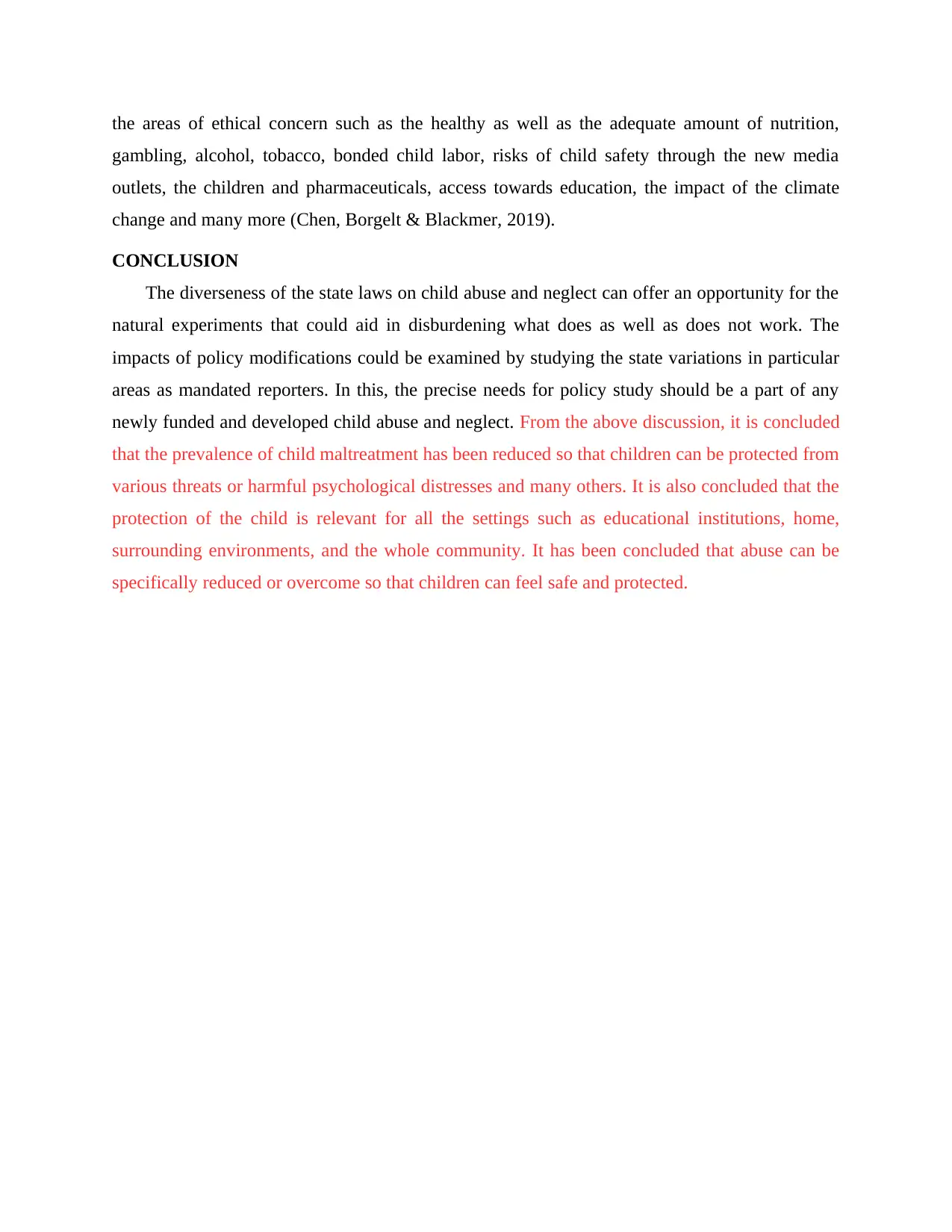
the areas of ethical concern such as the healthy as well as the adequate amount of nutrition,
gambling, alcohol, tobacco, bonded child labor, risks of child safety through the new media
outlets, the children and pharmaceuticals, access towards education, the impact of the climate
change and many more (Chen, Borgelt & Blackmer, 2019).
CONCLUSION
The diverseness of the state laws on child abuse and neglect can offer an opportunity for the
natural experiments that could aid in disburdening what does as well as does not work. The
impacts of policy modifications could be examined by studying the state variations in particular
areas as mandated reporters. In this, the precise needs for policy study should be a part of any
newly funded and developed child abuse and neglect. From the above discussion, it is concluded
that the prevalence of child maltreatment has been reduced so that children can be protected from
various threats or harmful psychological distresses and many others. It is also concluded that the
protection of the child is relevant for all the settings such as educational institutions, home,
surrounding environments, and the whole community. It has been concluded that abuse can be
specifically reduced or overcome so that children can feel safe and protected.
gambling, alcohol, tobacco, bonded child labor, risks of child safety through the new media
outlets, the children and pharmaceuticals, access towards education, the impact of the climate
change and many more (Chen, Borgelt & Blackmer, 2019).
CONCLUSION
The diverseness of the state laws on child abuse and neglect can offer an opportunity for the
natural experiments that could aid in disburdening what does as well as does not work. The
impacts of policy modifications could be examined by studying the state variations in particular
areas as mandated reporters. In this, the precise needs for policy study should be a part of any
newly funded and developed child abuse and neglect. From the above discussion, it is concluded
that the prevalence of child maltreatment has been reduced so that children can be protected from
various threats or harmful psychological distresses and many others. It is also concluded that the
protection of the child is relevant for all the settings such as educational institutions, home,
surrounding environments, and the whole community. It has been concluded that abuse can be
specifically reduced or overcome so that children can feel safe and protected.
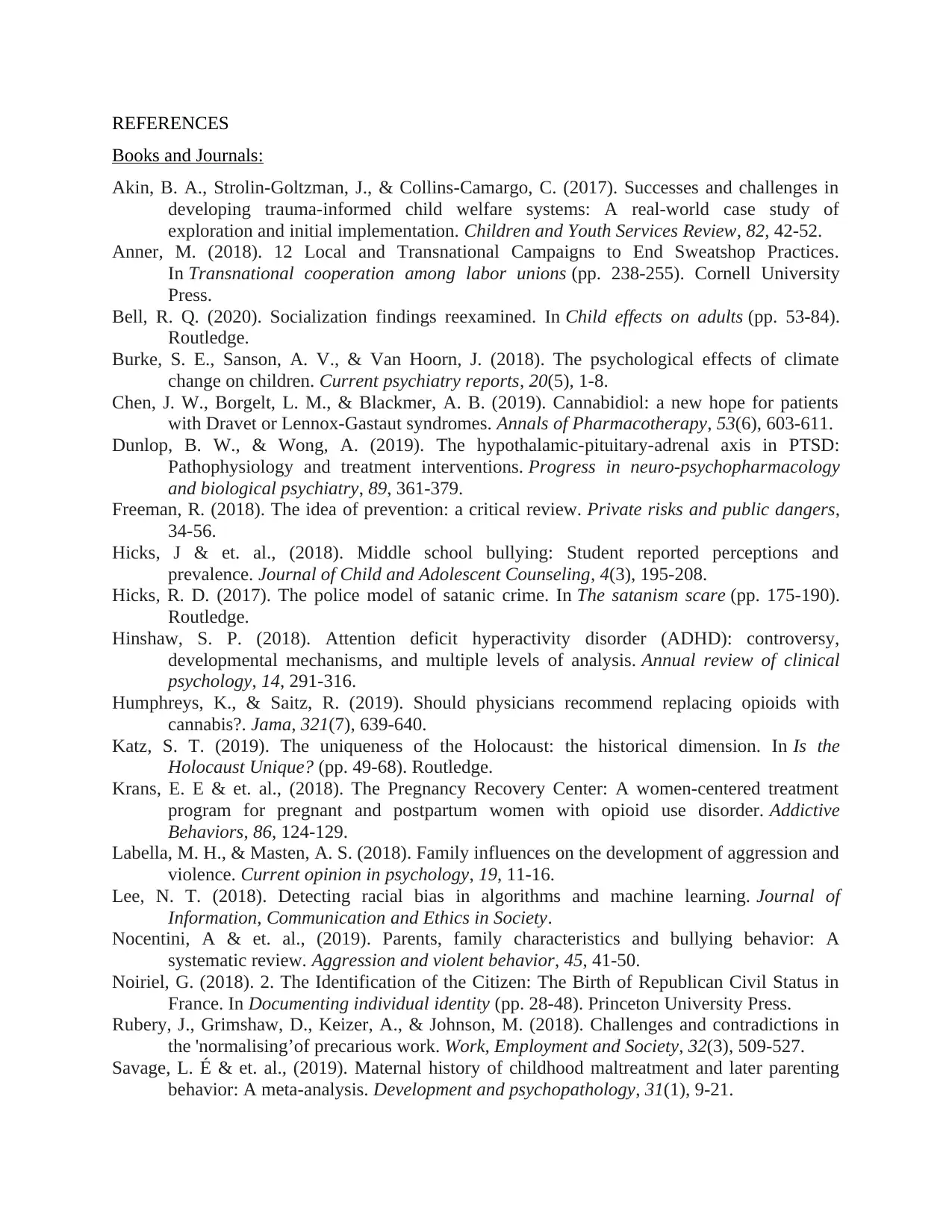
REFERENCES
Books and Journals:
Akin, B. A., Strolin-Goltzman, J., & Collins-Camargo, C. (2017). Successes and challenges in
developing trauma-informed child welfare systems: A real-world case study of
exploration and initial implementation. Children and Youth Services Review, 82, 42-52.
Anner, M. (2018). 12 Local and Transnational Campaigns to End Sweatshop Practices.
In Transnational cooperation among labor unions (pp. 238-255). Cornell University
Press.
Bell, R. Q. (2020). Socialization findings reexamined. In Child effects on adults (pp. 53-84).
Routledge.
Burke, S. E., Sanson, A. V., & Van Hoorn, J. (2018). The psychological effects of climate
change on children. Current psychiatry reports, 20(5), 1-8.
Chen, J. W., Borgelt, L. M., & Blackmer, A. B. (2019). Cannabidiol: a new hope for patients
with Dravet or Lennox-Gastaut syndromes. Annals of Pharmacotherapy, 53(6), 603-611.
Dunlop, B. W., & Wong, A. (2019). The hypothalamic-pituitary-adrenal axis in PTSD:
Pathophysiology and treatment interventions. Progress in neuro-psychopharmacology
and biological psychiatry, 89, 361-379.
Freeman, R. (2018). The idea of prevention: a critical review. Private risks and public dangers,
34-56.
Hicks, J & et. al., (2018). Middle school bullying: Student reported perceptions and
prevalence. Journal of Child and Adolescent Counseling, 4(3), 195-208.
Hicks, R. D. (2017). The police model of satanic crime. In The satanism scare (pp. 175-190).
Routledge.
Hinshaw, S. P. (2018). Attention deficit hyperactivity disorder (ADHD): controversy,
developmental mechanisms, and multiple levels of analysis. Annual review of clinical
psychology, 14, 291-316.
Humphreys, K., & Saitz, R. (2019). Should physicians recommend replacing opioids with
cannabis?. Jama, 321(7), 639-640.
Katz, S. T. (2019). The uniqueness of the Holocaust: the historical dimension. In Is the
Holocaust Unique? (pp. 49-68). Routledge.
Krans, E. E & et. al., (2018). The Pregnancy Recovery Center: A women-centered treatment
program for pregnant and postpartum women with opioid use disorder. Addictive
Behaviors, 86, 124-129.
Labella, M. H., & Masten, A. S. (2018). Family influences on the development of aggression and
violence. Current opinion in psychology, 19, 11-16.
Lee, N. T. (2018). Detecting racial bias in algorithms and machine learning. Journal of
Information, Communication and Ethics in Society.
Nocentini, A & et. al., (2019). Parents, family characteristics and bullying behavior: A
systematic review. Aggression and violent behavior, 45, 41-50.
Noiriel, G. (2018). 2. The Identification of the Citizen: The Birth of Republican Civil Status in
France. In Documenting individual identity (pp. 28-48). Princeton University Press.
Rubery, J., Grimshaw, D., Keizer, A., & Johnson, M. (2018). Challenges and contradictions in
the 'normalising’of precarious work. Work, Employment and Society, 32(3), 509-527.
Savage, L. É & et. al., (2019). Maternal history of childhood maltreatment and later parenting
behavior: A meta-analysis. Development and psychopathology, 31(1), 9-21.
Books and Journals:
Akin, B. A., Strolin-Goltzman, J., & Collins-Camargo, C. (2017). Successes and challenges in
developing trauma-informed child welfare systems: A real-world case study of
exploration and initial implementation. Children and Youth Services Review, 82, 42-52.
Anner, M. (2018). 12 Local and Transnational Campaigns to End Sweatshop Practices.
In Transnational cooperation among labor unions (pp. 238-255). Cornell University
Press.
Bell, R. Q. (2020). Socialization findings reexamined. In Child effects on adults (pp. 53-84).
Routledge.
Burke, S. E., Sanson, A. V., & Van Hoorn, J. (2018). The psychological effects of climate
change on children. Current psychiatry reports, 20(5), 1-8.
Chen, J. W., Borgelt, L. M., & Blackmer, A. B. (2019). Cannabidiol: a new hope for patients
with Dravet or Lennox-Gastaut syndromes. Annals of Pharmacotherapy, 53(6), 603-611.
Dunlop, B. W., & Wong, A. (2019). The hypothalamic-pituitary-adrenal axis in PTSD:
Pathophysiology and treatment interventions. Progress in neuro-psychopharmacology
and biological psychiatry, 89, 361-379.
Freeman, R. (2018). The idea of prevention: a critical review. Private risks and public dangers,
34-56.
Hicks, J & et. al., (2018). Middle school bullying: Student reported perceptions and
prevalence. Journal of Child and Adolescent Counseling, 4(3), 195-208.
Hicks, R. D. (2017). The police model of satanic crime. In The satanism scare (pp. 175-190).
Routledge.
Hinshaw, S. P. (2018). Attention deficit hyperactivity disorder (ADHD): controversy,
developmental mechanisms, and multiple levels of analysis. Annual review of clinical
psychology, 14, 291-316.
Humphreys, K., & Saitz, R. (2019). Should physicians recommend replacing opioids with
cannabis?. Jama, 321(7), 639-640.
Katz, S. T. (2019). The uniqueness of the Holocaust: the historical dimension. In Is the
Holocaust Unique? (pp. 49-68). Routledge.
Krans, E. E & et. al., (2018). The Pregnancy Recovery Center: A women-centered treatment
program for pregnant and postpartum women with opioid use disorder. Addictive
Behaviors, 86, 124-129.
Labella, M. H., & Masten, A. S. (2018). Family influences on the development of aggression and
violence. Current opinion in psychology, 19, 11-16.
Lee, N. T. (2018). Detecting racial bias in algorithms and machine learning. Journal of
Information, Communication and Ethics in Society.
Nocentini, A & et. al., (2019). Parents, family characteristics and bullying behavior: A
systematic review. Aggression and violent behavior, 45, 41-50.
Noiriel, G. (2018). 2. The Identification of the Citizen: The Birth of Republican Civil Status in
France. In Documenting individual identity (pp. 28-48). Princeton University Press.
Rubery, J., Grimshaw, D., Keizer, A., & Johnson, M. (2018). Challenges and contradictions in
the 'normalising’of precarious work. Work, Employment and Society, 32(3), 509-527.
Savage, L. É & et. al., (2019). Maternal history of childhood maltreatment and later parenting
behavior: A meta-analysis. Development and psychopathology, 31(1), 9-21.
⊘ This is a preview!⊘
Do you want full access?
Subscribe today to unlock all pages.

Trusted by 1+ million students worldwide
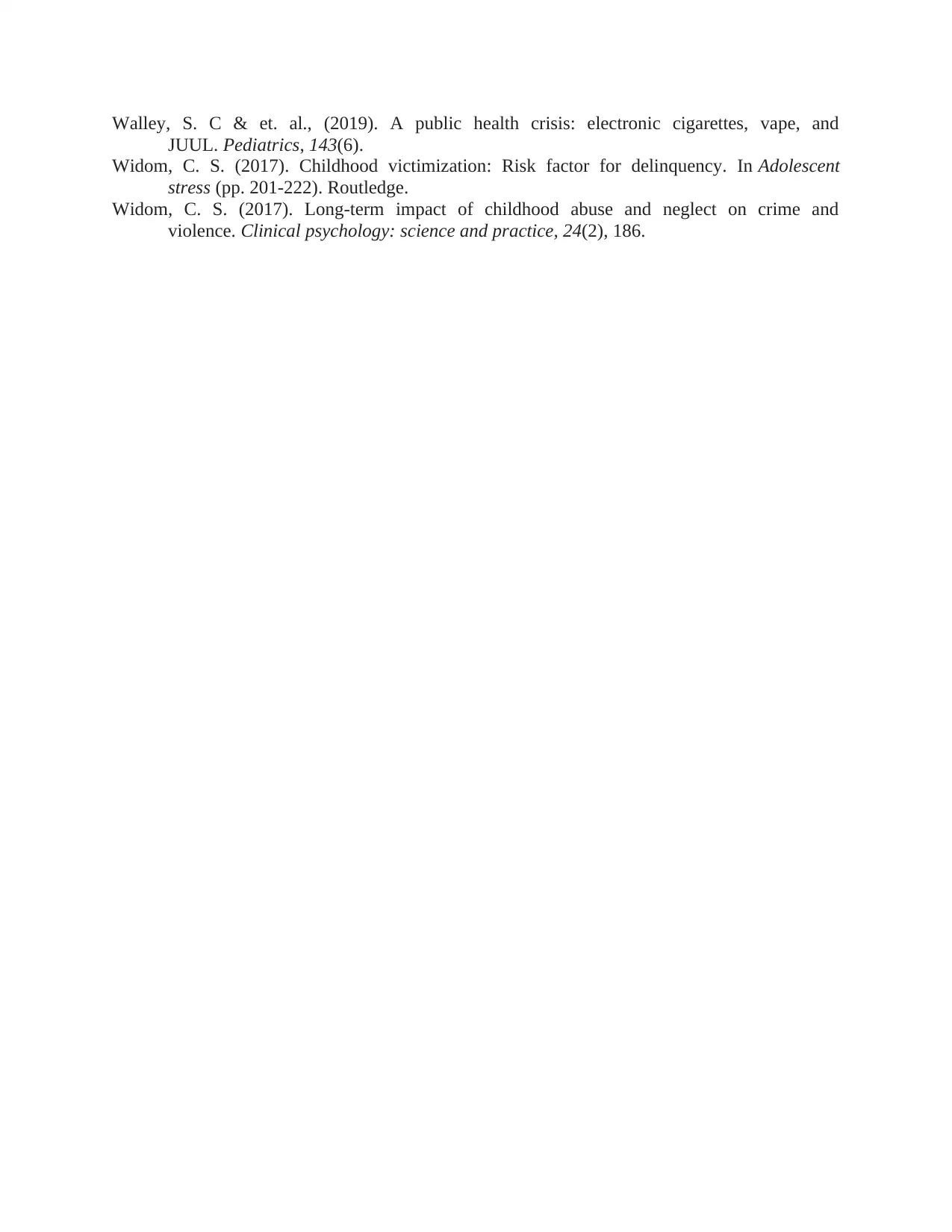
Walley, S. C & et. al., (2019). A public health crisis: electronic cigarettes, vape, and
JUUL. Pediatrics, 143(6).
Widom, C. S. (2017). Childhood victimization: Risk factor for delinquency. In Adolescent
stress (pp. 201-222). Routledge.
Widom, C. S. (2017). Long‐term impact of childhood abuse and neglect on crime and
violence. Clinical psychology: science and practice, 24(2), 186.
JUUL. Pediatrics, 143(6).
Widom, C. S. (2017). Childhood victimization: Risk factor for delinquency. In Adolescent
stress (pp. 201-222). Routledge.
Widom, C. S. (2017). Long‐term impact of childhood abuse and neglect on crime and
violence. Clinical psychology: science and practice, 24(2), 186.
1 out of 7
Related Documents
Your All-in-One AI-Powered Toolkit for Academic Success.
+13062052269
info@desklib.com
Available 24*7 on WhatsApp / Email
![[object Object]](/_next/static/media/star-bottom.7253800d.svg)
Unlock your academic potential
Copyright © 2020–2025 A2Z Services. All Rights Reserved. Developed and managed by ZUCOL.




